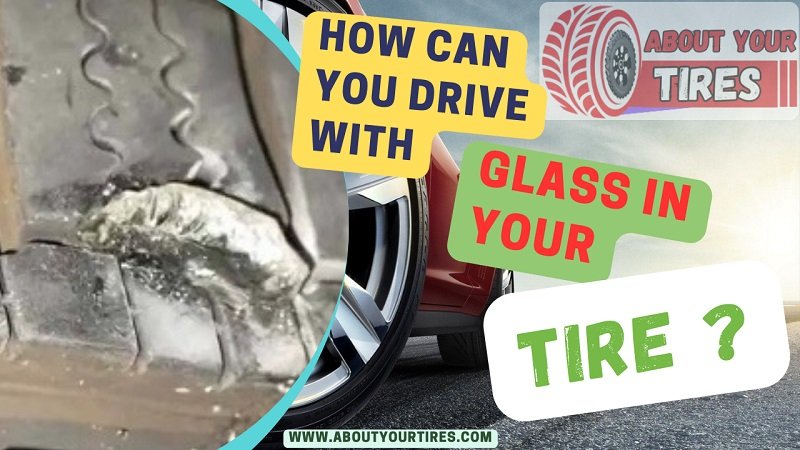It’s a scenario that’s bound to happen to everyone sooner or later. You step out of your vehicle after a long workday, only to spot a menacing shard of glass embedded in your tire. Sometimes the source of this unwelcome intruder is obvious, but on other occasions, it remains a mystery. The question that arises: Is it safe to continue driving with glass lodged in your tire? The answer may not be as clear-cut as you’d think.
Can You Safely Drive With Glass in Your Tire?
In many cases, driving with small quantities of glass in your tire is tolerable, as it may not always penetrate the rubber, thus averting the risk of a slow leak. However, certain types of glass, such as glass from bottles, can result in slow leaks that, if left unattended, may eventually lead to blowouts and flat tires.
Stay with us as we delve into the diverse impacts of various types of glass on your tires, learn how to detect a slow leak, and explore the methods to extract that bothersome glass from your tire.
Can Tires Tolerate Encounters with Glass?

In general, when you come across random glass fragments on the road, it’s best to exercise caution, as you won’t always be able to discern the type of glass you’re dealing with. Even if the glass doesn’t pierce the tire entirely, it can leave scratches, providing an ideal environment for moisture and debris accumulation. Over time, this can reduce your tire’s lifespan, but it takes a considerable period for this buildup to have a significant impact, typically around 10,000 miles down the road.
Most of the glass you encounter on roadways is likely sourced from vehicle headlights or windshields. Fortunately, these glass fragments tend to break into small, square pieces with minimal sharp edges, posing a lesser risk to your tires. However, glass from bottles, characterized by long, sharp spikes, can penetrate the rubber and cause more substantial damage. When in doubt about the glass type, your safest course of action is to steer clear.
How to Remove Glass from Your Tire
Before embarking on a mission to remove glass from your tire, it’s imperative to ensure your tire isn’t leaking. You can perform a simple test by spraying soapy water around the glass area. If bubbles form, it indicates a leak, and you should refrain from attempting removal.
Additionally, checking the tire pressure is essential. Low pressure can be a sign of a leak, though it’s not the sole explanation, as other factors can contribute to this issue. If a pressure gauge isn’t available, keep an eye on your dashboard. Most vehicles are equipped with sensors that illuminate when tire pressure drops to an unsafe level.
Assuming your tire isn’t leaking, you can use a pair of pliers, while wearing gloves, to work the glass out. It’s crucial to avoid any mishaps, as you certainly wouldn’t want the glass to end up in your hand. Alternatively, a visit to a tire shop capable of repairing tires rather than merely replacing them is often a faster and more efficient way to remove the glass.
Can Glass Actually Puncture Tires?
Yes, but it’s important to note that not all glass types are equally threatening to your tires. Windshields and car mirrors are constructed using a specialized glass that shatters into pebble-like fragments instead of sharp shards. As a result, these components are engineered to minimize damage to your vehicle, including your tires.
Conversely, other types of glass, such as broken bottles in parking lots, are more likely to puncture tires. These glasses are not designed with tire safety in mind. Furthermore, glass is most prone to puncturing tires during the summer when the rubber of your tires is softer and more susceptible to damage. So, during warmer weather, it’s wise to exercise caution when navigating over glass-covered terrain.
Will Driving Over Glass Inevitably Lead to a Flat Tire?
Not necessarily. There are numerous instances where driving over glass won’t result in a flat tire. The glass typically used in cars, like windshields and mirrors, is designed to be tire-safe, so you’re unlikely to encounter issues when driving over these fragments. However, certain types of glass, such as broken bottles, can indeed pose a risk to your tires, especially when found in parking lots.
It’s important to remain vigilant when glass is on the road, particularly when it originates from vehicles or bottles, as it can damage your tires. Therefore, it’s generally advisable to steer clear of it if you’re unsure of its nature.
In conclusion, not all glass presents a threat to your tires. While some types, like those used in windshields, are tire-safe, others can potentially cause damage, resulting in slow leaks or blowouts. However, it’s worth noting that glass can sometimes lodge itself in your tire without causing any issues, in which case it can be removed without much trouble, either by yourself or by seeking professional assistance.

